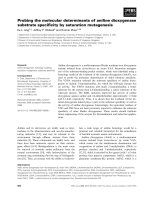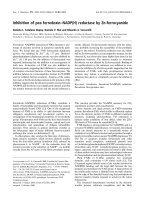Bipolar Disorder – A Portrait of a Complex Mood Disorder Edited by Jarrett Barnhill docx
Bạn đang xem bản rút gọn của tài liệu. Xem và tải ngay bản đầy đủ của tài liệu tại đây (4.47 MB, 250 trang )
BIPOLAR DISORDER –
A PORTRAIT OF A COMPLEX
MOOD DISORDER
Edited by Jarrett Barnhill
Bipolar Disorder – A Portrait of a Complex Mood Disorder
Edited by Jarrett Barnhill
Published by InTech
Janeza Trdine 9, 51000 Rijeka, Croatia
Copyright © 2012 InTech
All chapters are Open Access distributed under the Creative Commons Attribution 3.0
license, which allows users to download, copy and build upon published articles even for
commercial purposes, as long as the author and publisher are properly credited, which
ensures maximum dissemination and a wider impact of our publications. After this work
has been published by InTech, authors have the right to republish it, in whole or part, in
any publication of which they are the author, and to make other personal use of the
work. Any republication, referencing or personal use of the work must explicitly identify
the original source.
As for readers, this license allows users to download, copy and build upon published
chapters even for commercial purposes, as long as the author and publisher are properly
credited, which ensures maximum dissemination and a wider impact of our publications.
Notice
Statements and opinions expressed in the chapters are these of the individual contributors
and not necessarily those of the editors or publisher. No responsibility is accepted for the
accuracy of information contained in the published chapters. The publisher assumes no
responsibility for any damage or injury to persons or property arising out of the use of any
materials, instructions, methods or ideas contained in the book.
Publishing Process Manager Dragana Manestar
Technical Editor Teodora Smiljanic
Cover Designer InTech Design Team
First published February, 2012
Printed in Croatia
A free online edition of this book is available at www.intechopen.com
Additional hard copies can be obtained from
Bipolar Disorder – A Portrait of a Complex Mood Disorder, Edited by Jarrett Barnhill
p. cm.
978-953-51-0002-7
Contents
Preface IX
Part 1 Basic Science Issues 1
Chapter 1 Bivalent Cations in Bipolar Disorders 3
Mihai Nechifor, Cristina Vaideanu and Florina Crivoi
Chapter 2 Anti-Stress Effects of Mood Stabilizers and
Relevance to Their Therapeutic Actions 17
Young-Ki Chung and Seungmin Yoo
Chapter 3 Lithium Enhances Synaptic Plasticity:
Implication for Treatment of Bipolar Disorder 41
Seong S. Shim
Part 2 Neuropharmacological Challenges 55
Chapter 4 Li
+
in Bipolar Disorder – Possible
Mechanisms of Its Pharmacological Mode of Action 57
Carla P. Fonseca, Liliana P. Montezinho and M. Margarida C.A. Castro
Chapter 5 Memantine: A New Mood Stabilizer for
Treatment-Resistant Bipolar Disorders 99
Gino Serra, Giulia Serra, Alexia E. Koukopoulos,
Francesca Demontis and Athanasio Koukopoulos
Chapter 6 Bipolar Disorder and Suicide 121
Dagmar Breznoščáková
Part 3 Neurodevelopmental Aspects 143
Chapter 7 Correlations Between the Monoaminergic
Status and the Psychoneuroendocrine
Typology in a Murine Model – Possible Biomolecular
Predictions for an Individualized Pharmacotherapy 145
Andreea Letitia Arsene, Niculina Mitrea and Dumitru Lupuliasa
VI Contents
Chapter 8 Paediatric Bipolar Disorder –
Are Attachment and Trauma Factors Considered? 165
Peter I. Parry
Part 4 Psychosocial Approaches 191
Chapter 9 Psychosocial Functioning in
Bipolar Disorder from a Social Justice Perspective 193
Emily Manove, Lauren M. Price and Boaz Levy
Chapter 10 Star Shots: Stigma,
Self-Disclosure and Celebrity in Bipolar Disorder 221
Wendy Cross and Ken Walsh
Preface
This volume addresses the many faces of Bipolar Disorder (BD). To complete this
portrait, we need to explore not only clinical symptoms and treatment responses, but
also gene-environment interactions, epigenetics, stress response systems, and
psychosocial forces that impact mood disorders in general and BD in particular. From
a clinical perspective, the age of onset, severity, and patterns of cycling and symptoms
influence clinical course, venue, and treatment decision making. In this edition we
address the complexity of BD by focusing on basic neurosciences research, especially
the role of neuro-plasticity; multiple neurotransmitter systems; first and second
messenger systems; the capacity of several mood stabilizers to alter stress response
systems, regulators of circadian rhythms, and the underlying neurophysiology of
treating BD. The fundamental processes are addressed in depth by Drs Mahai
(bivalent cations in mania); Seong (lithium effects on neuroplasticity); Gino (a novel
treatment approach to treatment based on modulating glutaminergic activity
treatment with Memantine) and Margarida (the effects of lithium on intracellular
mechanisms related to phosphoinositol, GSK3 and other messenger systems).
Clinical heterogeneity is the most challenging feature of major psychiatric disorders. A
significant contributor to this heterogeneity is gene-environmental interactions. In
keeping with this challenge, Dr Young-Ki addresses the relationship between stress,
BD and the role many mood stabilizers pay in modulating the stress response systems
(neuro-immunological and neuro-endocrinological systems). Her insights and
observations are germane to our understanding of the lifelong changes in the nature
and course of BD. One area of intense interest is the boundary and transformation
point between high levels of reactivity early in the course of BD to one that seems to be
an expression of primarily endogenous events. This “developmental” characteristic of
BD is complicated by frequent relapses over time and points us toward kindling,
episode sensitization and alterations in neuroplastic responses by recurring
symptoms.
In recent years, there is growing interest in the relationship between “soft” forms of
BD, namely sub-clinical or sub-syndromal forms (BD. NOS). These subsyndromal
forms are grouped under BD spectrum disorder. If we turn our attention to
prepubertal onset BD we also confront boundary problems associated with atypical or
temperamental presentations of ADHD and severe affective instability, irritability, and
X Preface
explosive behaviors. In this edition Dr Andreea addresses neurobiological features of
affect regulation and expression. This chapter dovetails nicely into Dr Peter's review of
the problems child psychiatrists encounter, and in some situations create, when
dealing with prepubertal onset BD. The boundary between genetic risk for BD and
severe temperamental differences, ADHD, abuse and neglect, and affect dysregulation
enter into these considerations.
These variations in the presentation of classic BD segue into the markedly increased
risk for both attempted and completed suicide in the disorder. Factors such as
recurring depression in BP II patients, presence of mixed mood states and subtype
early age of onset, substance use, and psychiatric comorbidity contribute to potential
suicidal behaviors. For example, many individuals with BD.NOS, Bipolar II (recurring
depression), and mixed mood states experience longstanding social and occupational
morbidity, prolonged periods of mood-related symptoms and increased risk of
suicide. Dr Dagmar provides a thorough analysis of epidemiological research and
clinical data that addresses the risks for suicidal behavior and completed suicide in
BD.
Dr Levy addresses the complex psychosocial issues that encompass BD. In our era of
psychopharmacological treatments, various psychotherapy formats are often
overlooked or underemphasized. The role of psychotherapy in enhancing quality of
life, relapse prevention, adjuncts for treatment resistant patients, and a methodology
of closely monitoring patients for early relapse at key points in their clinical course,
can be critical for successful outcomes. Increased mastery of the psychosocial
consequences of BD may also play a key role in suicide prevention by enhancing
family functioning as well as cognitive behavioral and interpersonal skill sets.
Dr Wendy culminates this volume on a broader medical sociological note. BD is a
costly and life-altering disorder that can adversely affect not only quality of life but
also occupation, educational, and family functioning. Dr Wendy explores the impact of
disclosure on these parameters. In addition, the author investigates the often
ambiguous territory of illness disclosure in terms of stigmatization and social role
changes due to occupational and family dysfunction and repeated hospitalizations.
These psychosocial issues affect one's willingness to accept the diagnosis, comply with
treatment recommendations, and levels of subjective distress and morbidity related to
a chronic relapsing disorder. The author then turns to the impact of disclosure by
celebrities on stigmatization and social acceptance. Even though Dr Wendy focuses on
psychosocial factors, these findings can be extrapolated to chapters on
neurophysiological parameters associated with occupational distress, social isolation,
and sense of alienation, shame/guilt, and other risk factors for both recurrence and
treatment resistance.
Bipolar Disorder: A Portrait of a Complex Mood Disorder captures only a portion of the
variability and heterogeneity of what we call BD. This book begs the question of
approaching BD in terms of a combination of descriptive and etiopathogenic
Preface XI
approaches. By doing so, clinicians can apply new research in the neurosciences to the
process of differential diagnosis and treatment planning. This approach requires a
more detailed understanding of BD, especially the forces underlying differences in
typology of mood, polarity, comorbidity, molecular genetics, gender expression, and
age of onset. For example, female patients with a family history of BD who experience
a single episode of depression remain at risk to some degree for recurring depression,
treatment resistance and/or switch potential switch to hypomania. A similar patient
victimized by severe physical or sexual abuse and neglect may present with more
substantial neuroendocrine dysregulation who have to cope with neuroendocrine
changes that influence course and treatment outcome. In contrast, those patients with
a classic pattern of well-defined periods of recurring mania alternating with
depression; positive family history of lithium responsive BD, male gender, may
constitute a more specific endophenotype. Defining such endophenotypes may
decrease the level of clinical heterogeneity and help improve diagnosis rigor and
treatment response.
Unfortunately, between these two endpoints remain multiple variations of the BD
theme. For example, we also grapple with the boundary between psychotic mood and
schizophrenia spectrum disorders. These patients can present with mania or
depression with psychotic features (severity dimension); combined symptoms
associated with both schizophrenia and mood disorder (schizoaffective disorders), and
suggest the boundary between mood and schizophrenic disorders is more permeable
than previously acknowledged. In the early 20
th
century, these disorders were
considered distinct clinical entities. “Hybrids” between these dichotomized disorders
now include schizoaffective disorders. Recent research suggests a possible genetic link
based on the presence of psychotic symptoms, there are mood disorders, thought
disorders, and then a different risk factor for floridly psychotic forms of each.
Gender and age of onset have significant influences on the clinical presentation and
treatment decisions. Among individuals with depression, the gender ratio is nearly 2:1
for females when compared to males. Among individuals with bipolar illness, the
gender ratio is nearly equal. Age of onset provides another source of variability. The
peak age of onset for unipolar depression is after 40, while the peak onset for bipolar-
related mood disorders is often in the late teens and early twenties. The onset of any
subtype of mood disorder during childhood tilts the long-term outcome towards
chronicity, bipolarity, high rates of comorbid substance use disorders, and
comorbidity (including personality disorders. There is a great deal of controversy in
child psychiatry about the nature of pre-pubertal early onset bipolar illness, especially
since many children may lack clear-cut cyclical changes or present with a mixture of
affective symptoms.
In terms of clinical course or longitudinal outcomes, there is a tendency towards
increasing frequency and longer duration of episodes; shift towards rapid cycling
(more common in females with thyroid dysfunction), and in some circumstances
XII Preface
resistance to previously effective treatments. For example, lithium responsive versus
valproic responsive individuals may differ in terms of typology, severity, and duration
of illness factors. Individuals with comorbid neurological disorders may show similar
difference in treatment responsiveness.
Bipolar Disorder: Portrait of a Complex Mood Disorder is a step towards integrating many
diverse perspectives on BD. As we shall see, such diversity makes it difficult to clearly
define the boundaries of BD. It is helpful to view BD from this perspective, as a final
common pathway arises from multiple frames of reference. The integration of
epigenetics, molecular pharmacology, and neurophysiology is essential. One solution
involves using this diverse data to search for endophenotypes to aid researchers, even
though most clinicians prefer broader groupings of symptoms and clinical variables.
Our challenge is to consolidate this new information with existing clinical practice in a
usable fashion. This need for convergent thinkers who can integrate the findings in
this book remains a critical need. This book is a small step in that direction and
hopefully guides researchers and clinicians towards a new synthesis of basic
neurosciences and clinical psychiatry
Jarrett Barnhill MD, DFAPA, FAACAP
Department of Psychiatry, University of North Carolina School of Medicine,
Chapel Hill, NC,
USA
References
Goodwin FK, Jamison KR. Manic-Depressive Illness: Bipolar Disorders and Recurring
Depression, 2007 New York: Oxford University Press. ISBN: 13-978-0-19-
513579-4.
Knapp P, Mastergeorge AM (2009). Clinical Implications of Current Finding in
Neurodevelopment. Psychiatric Clinics of North America 32 (1): 177-198.
Ludd LL, Akiskal HS, Schletter DA et al (2003(. The Comparative Clinical Phenotype
and Long Term Longitudinal Course of Bipolar I and II: A Clinical Spectrum.
J Affect Disorders 73(12):19-32.
Mazzarrini L, Vieta E (2010). Toward a Valid Classification of Psychosis: Overcoming
the Schizophrenia-Bipolar Dichotomy. Psych Annals 40(3): 143-8.
Myers AJ, Nemeroff CB (2010). New Vistas in the Management of Treatment-
Refractory Psychiatric Disorders: Genomics and Personalized Medicine.
Focus: J. of Life Long Learning in Psychiatry 8(4):525-35.
Osuji IJ, Cullum CM (2005). Cognition in Bipolar Disorder. Psychiatric Clinics North
America 28(2): 427-442.
Scott J, Colom F (2005) Psychosocial Treatments for Bipolar Disorders. Psychiatric
Clinic of North America 28(2): 371- 84.
Part 1
Basic Science Issues









